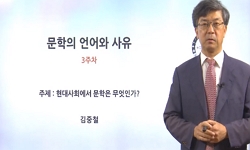본 논문은 우선 발터 벤야민의 사상을 그의 알레고리론을 중심으로 정리하면서 벤야민의 알레고리론의 핵심은 그 근본적인 역사적 성격에 있음을 집중적으로 분석하였다. 벤야민에 따르면 ...
http://chineseinput.net/에서 pinyin(병음)방식으로 중국어를 변환할 수 있습니다.
변환된 중국어를 복사하여 사용하시면 됩니다.
- 中文 을 입력하시려면 zhongwen을 입력하시고 space를누르시면됩니다.
- 北京 을 입력하시려면 beijing을 입력하시고 space를 누르시면 됩니다.
https://www.riss.kr/link?id=A82726636
- 저자
- 발행기관
- 학술지명
- 권호사항
-
발행연도
2011
-
작성언어
Korean
- 주제어
-
KDC
809
-
등재정보
KCI등재
-
자료형태
학술저널
-
수록면
387-423(37쪽)
-
KCI 피인용횟수
29
- 제공처
- 소장기관
-
0
상세조회 -
0
다운로드
부가정보
국문 초록 (Abstract)
그런데 벤야민의 역사적 알레고리론은 유대교적 신비주의라는 얼핏 비역사적이고 초월적인 사상을 동시에 내포하고 있다. 철저하게 역사적인 사유방식과 신학적 신비주의가 공존하는 양상은 벤야민이 마르크스의 역사적 유물론을 본격적으로 수용한 1930년대의 글에서도 이어진다. 이에 대해 많은 논자들은 벤야민의 사상에 일관성과 체계성이 결여되어 있다는 비판을 제기하였다. 그러나 벤야민의 신학적 메시아니즘은 철저하게 역사적인 관점에서만 온전하게 이해될 수 있다.
본 논문은 벤야민의 사상을 특히 언어이론과 시학의 관점에서 재구성하기 위한 예비 작업이다. 그의 알레고리론이 현실을 역사적 총체성의 관점에서 재구성하는 것이라고 할 때 그것은 곧 현실과 역사의'의미작용방식'을 알레고리적으로 재구성한다는 것을 의미한다. 현실과 역사의 의미가 문제의 중심에 놓일 때 어떤 이론도'언어'의 문제를 회피할 수 없다. 벤야민은 지적 활동의 초기 단계에서부터 자신의 신학적인 동시에 역사적인 언어관과 시학을 체계화하는데 주력하였다. 그리고 그의 언어이론의 핵심에는 시와 문학이 있다. 벤야민에 따르면 인간의 다양한 언어활동가운데 시는 표면적인 메시지가 아니라 언어적 의미구성의 방법론 자체를 재구성하는 예술적 언어활동이다. 즉 벤야민의 언어이론과 시학에 대한 이해 없이 그의 사상을 총체적으로 이해하는 것은 불가능하다. 그런데 벤야민의 언어이론과 시학의 근본적인 역사적 성격을 고려할 때 이는 한국문학을 새롭게 이해할 수 있는 중요한 이론적 참조사항이 될 수 있다.
본 논문은 우선 발터 벤야민의 사상을 그의 알레고리론을 중심으로 정리하면서 벤야민의 알레고리론의 핵심은 그 근본적인 역사적 성격에 있음을 집중적으로 분석하였다. 벤야민에 따르면 알레고리의 역사적 성격은 상징의 비역사적이고 신화적인 성격에 대립된다. 상징이 초월적이고 비역사적인 현상과 본질의 일치를 가정한다면 알레고리는 역사적 현실과 초월적인 통합의 미적 이데올로기 사이의 균열을 직시한다. 알레고리는 상징의 초월적인 보편성과는 달리 현실의 균열지점들을 몽타주하면서 이를 통해 역사와 현실의 총체성을 현재적으로 재구성하는 사유의 방법론이다. 즉 알레고리는 현실의 의미작용양상을 철저하게 역사적인 관점에서 재구성하는 사유와 글쓰기의 방법론이다.
그런데 벤야민의 역사적 알레고리론은 유대교적 신비주의라는 얼핏 비역사적이고 초월적인 사상을 동시에 내포하고 있다. 철저하게 역사적인 사유방식과 신학적 신비주의가 공존하는 양상은 벤야민이 마르크스의 역사적 유물론을 본격적으로 수용한 1930년대의 글에서도 이어진다. 이에 대해 많은 논자들은 벤야민의 사상에 일관성과 체계성이 결여되어 있다는 비판을 제기하였다. 그러나 벤야민의 신학적 메시아니즘은 철저하게 역사적인 관점에서만 온전하게 이해될 수 있다.
본 논문은 벤야민의 사상을 특히 언어이론과 시학의 관점에서 재구성하기 위한 예비 작업이다. 그의 알레고리론이 현실을 역사적 총체성의 관점에서 재구성하는 것이라고 할 때 그것은 곧 현실과 역사의'의미작용방식'을 알레고리적으로 재구성한다는 것을 의미한다. 현실과 역사의 의미가 문제의 중심에 놓일 때 어떤 이론도'언어'의 문제를 회피할 수 없다. 벤야민은 지적 활동의 초기 단계에서부터 자신의 신학적인 동시에 역사적인 언어관과 시학을 체계화하는데 주력하였다. 그리고 그의 언어이론의 핵심에는 시와 문학이 있다. 벤야민에 따르면 인간의 다양한 언어활동가운데 시는 표면적인 메시지가 아니라 언어적 의미구성의 방법론 자체를 재구성하는 예술적 언어활동이다. 즉 벤야민의 언어이론과 시학에 대한 이해 없이 그의 사상을 총체적으로 이해하는 것은 불가능하다. 그런데 벤야민의 언어이론과 시학의 근본적인 역사적 성격을 고려할 때 이는 한국문학을 새롭게 이해할 수 있는 중요한 이론적 참조사항이 될 수 있다.
다국어 초록 (Multilingual Abstract)
However the Benjamin's theory of historical allegory contains a judaic mysticism which seems to be unhistorical and transcendental. The coexistence of the radically historical methode of thought and the theological mysticism continued in his 1930s writings when he had accepted the historical materialism of marxism. Concerning this coexistence many theorists criticized the lack of coherence and systemicity. But the theological messianism in Benjamin's thought can be completely understood from his radically historical point of view.
This paper is a preparation to recompose Benjamin's thought by the linguistic theory and poetics. If the Benjamin's theory of allegory is a total recomposition of reality from his radically historical point of view it means that his writing allegorically recompose'the mode of signification' of the reality and the history. When the sens of reality and history become a major problem any theory can not avoid the problem of language. From his first period of thought Benjamin concentrated on a systemization of his theological and historical linguistic and poetics. And the poem and the literature exist in the center of his linguistic theory. Benjamin thinks that the poem is an artistic act of language which recompose the mode of linguistic formation of meaning itself not his superficial message. Finally it is impossible to completely understand Benjamin's thought without a comprehension of his linguistic and poetics. And considering the radical historicity of Benjamin's linguistic and poetics It can be an important reference to newly recompose the korean literature.
In the first place this paper is to examine the Walter Benjamin's theory of allegory who took the position that the allegory's specificity is based on its radical historicity. Benjamin oppose the historical aspect of allegory to the unhistorical and m...
In the first place this paper is to examine the Walter Benjamin's theory of allegory who took the position that the allegory's specificity is based on its radical historicity. Benjamin oppose the historical aspect of allegory to the unhistorical and mythic aspect of symbol. Contrary to the symbol which suppose the transcendental and unhistorical unity of the phenomenon and the essence the allegory takes the rupture between the historical reality and the esthetic ideology of transcendental unity as it is. By the montage of the ruptures of reality the allegory come to be a methode of thinking which recompose the total history and reality of the day. It means that the allegory is the methode of thinking and writing which recompose the mode of signification of the reality from a radically historical point of view.
However the Benjamin's theory of historical allegory contains a judaic mysticism which seems to be unhistorical and transcendental. The coexistence of the radically historical methode of thought and the theological mysticism continued in his 1930s writings when he had accepted the historical materialism of marxism. Concerning this coexistence many theorists criticized the lack of coherence and systemicity. But the theological messianism in Benjamin's thought can be completely understood from his radically historical point of view.
This paper is a preparation to recompose Benjamin's thought by the linguistic theory and poetics. If the Benjamin's theory of allegory is a total recomposition of reality from his radically historical point of view it means that his writing allegorically recompose'the mode of signification' of the reality and the history. When the sens of reality and history become a major problem any theory can not avoid the problem of language. From his first period of thought Benjamin concentrated on a systemization of his theological and historical linguistic and poetics. And the poem and the literature exist in the center of his linguistic theory. Benjamin thinks that the poem is an artistic act of language which recompose the mode of linguistic formation of meaning itself not his superficial message. Finally it is impossible to completely understand Benjamin's thought without a comprehension of his linguistic and poetics. And considering the radical historicity of Benjamin's linguistic and poetics It can be an important reference to newly recompose the korean literature.
목차 (Table of Contents)
- 국문 초록
- 1. 들어가며
- 2. 알레고리와 상징
- 3. 의미작용양식으로서의 알레고리와 몽타주
- 4. 벤야민의 역사적 유물론과 신학적 메시아니즘
- 국문 초록
- 1. 들어가며
- 2. 알레고리와 상징
- 3. 의미작용양식으로서의 알레고리와 몽타주
- 4. 벤야민의 역사적 유물론과 신학적 메시아니즘
- 5. 알레고리의 언어학과 시학
- 6. 나오며
- 참고문헌
- Abstract
참고문헌 (Reference)
1 샤를 보들레르, "파리의 우울" 민음사 2008
2 김지하, "타는 목마름으로" 창작과비평사 1982
3 샤를 보들레르, "악의 꽃" 문학과지성사 2003
4 발터 벤야민, "아케이드 프로젝트" 새물결 2005
5 강수미, "아이스테시스, 발터 벤야민과 사유하는 미학" 글항아리 2011
6 권용선, "세계와 역사의 몽타주, 벤야민의 아케이드 프로젝트" 그린비 2009
7 황지우, "새들도 세상을 뜨는구나" 문학과지성사 1983
8 발터 벤야민, "베를린의 유년시절" 솔 1992
9 발터 벤야민, "발터 벤야민 선집1-6" 길 2007
10 독일 비애극의 원천, "발터 벤야민" 새물결 2008
1 샤를 보들레르, "파리의 우울" 민음사 2008
2 김지하, "타는 목마름으로" 창작과비평사 1982
3 샤를 보들레르, "악의 꽃" 문학과지성사 2003
4 발터 벤야민, "아케이드 프로젝트" 새물결 2005
5 강수미, "아이스테시스, 발터 벤야민과 사유하는 미학" 글항아리 2011
6 권용선, "세계와 역사의 몽타주, 벤야민의 아케이드 프로젝트" 그린비 2009
7 황지우, "새들도 세상을 뜨는구나" 문학과지성사 1983
8 발터 벤야민, "베를린의 유년시절" 솔 1992
9 발터 벤야민, "발터 벤야민 선집1-6" 길 2007
10 독일 비애극의 원천, "발터 벤야민" 새물결 2008
11 발터 벤야민, "모더니티와 도시" 라움 2010
12 황지우, "나는 너다" 풀빛 1987
13 고지현, "꿈과 깨어나기" 유로서적 2007
14 김수영, "김수영 전집 2-산문" 민음사 2003
15 김수영, "김수영 전집 1-시" 민음사 2003
16 황지우, "겨울-나무로부터 봄-나무에로" 민음사 1985
17 Catherine Perret, "“L’Allégorie: une politique de la transmission?” in revue Europe" Avril 1996
18 Henri Meschonnic, "“L'allégorie chez Walter Benjamin, une aventure juive” in L'Utopie du Juif" Desclée de Brouwer 2001
19 Walter Benjamin, "et Paris, études réunies et présentées par HeinzWismann" Cerf 1986
20 Walter Benjamin, "Un poète lyrique à l’apogée ducapitalisme" Payot 1979
21 Walter Benjamin, "Paris, capitale du ⅩⅨ siècle, le livre des passages" Cerf 2006
22 Walter Benjamin, "Origine du drame baroque allemand" Flammarion 1985
23 Walter Benjamin, "OEuvres Ⅰ⋅Ⅱ⋅Ⅲ" Gallimard 2000
24 Charles Baudelaire, "OEuvres complètes" Robert Laffont 1980
25 Walter Benjamin, "Essais sur Brecht" La Fabrique 2003
26 Theodor W.Adorno, "Correspondance 1928-1940" Gallimard 2006
동일학술지(권/호) 다른 논문
-
- 韓國批評文學會
- 서영인(Seo Young-In)
- 2011
- KCI등재
-
- 韓國批評文學會
- 김종훈(Kim Jong-Hoon)
- 2011
- KCI등재
-
- 韓國批評文學會
- 오형엽(Oh Hyung-yup)
- 2011
- KCI등재
-
- 韓國批評文學會
- 이혜진(李慧眞)
- 2011
- KCI등재
분석정보
인용정보 인용지수 설명보기
학술지 이력
| 연월일 | 이력구분 | 이력상세 | 등재구분 |
|---|---|---|---|
| 2027 | 평가예정 | 재인증평가 신청대상 (재인증) | |
| 2021-01-01 | 평가 | 등재학술지 유지 (재인증) |  |
| 2018-01-01 | 평가 | 등재학술지 유지 (등재유지) |  |
| 2015-01-01 | 평가 | 등재학술지 선정 (계속평가) |  |
| 2013-04-01 | 평가 | 등재후보로 하락(현장점검) (기타) |  |
| 2013-01-01 | 평가 | 등재후보학술지 유지 (기타) |  |
| 2010-01-01 | 평가 | 등재학술지 유지 (등재유지) |  |
| 2007-01-01 | 평가 | 등재학술지 선정 (등재후보2차) |  |
| 2006-01-01 | 평가 | 등재후보 1차 PASS (등재후보1차) |  |
| 2005-01-01 | 평가 | 등재후보학술지 유지 (등재후보1차) |  |
| 2004-01-01 | 평가 | 등재후보 1차 FAIL (등재후보1차) |  |
| 2003-01-01 | 평가 | 등재후보학술지 선정 (신규평가) |  |
학술지 인용정보
| 기준연도 | WOS-KCI 통합IF(2년) | KCIF(2년) | KCIF(3년) |
|---|---|---|---|
| 2016 | 0.39 | 0.39 | 0.41 |
| KCIF(4년) | KCIF(5년) | 중심성지수(3년) | 즉시성지수 |
| 0.5 | 0.5 | 0.701 | 0.17 |




 DBpia
DBpia







